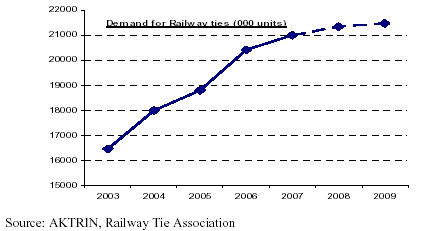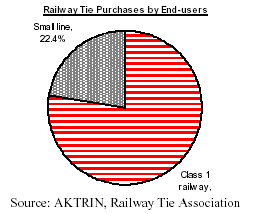|
Fed cuts rates by 50 points, foreclosures jump
The Economist reported on the Federal Reserve¡¯s decision to cut interest rates by 50 basis
points. The move was made to avoid harm to the global economy, due to the US
subprime mortgage fallout and weak credit markets. Recent statistics by RealtyTrac also showed that
home foreclosures jumped 36% in August. Experts anticipate forthcoming rate cut by the Fed at its next meeting.
Rising demand for American hardwoods for railway ties
Overall, the American hardwood industry is not performing well, mainly as a result of the
slumping US housing market. However, there are a few sectors in the industry that seem to
have escaped the general downturn. Demand for wood flooring and for wood from
transportation-related industries are holding up fairly well. In particular, the markets for wooden
truck trailer flooring, pallets, skids, crates, and railway ties remain healthy. The
following article focuses on the railway tie industry.
Real GDP growth is one of the main drivers for cross tie purchases. Growth stood at
approximately 3%, both in 2005 and 2006. No doubt, a cooling US economy could
slow the railway tie market in the next few years, but is not likely to cause a declining trend. Growth may fall
below 2% in 2007 and only marginally above this mark next year.¡¡
¡¡
Another important driver is railroad shipments of bulk products. Due to the increase of global
trade, railroads have been outperforming the overall economy. Furthermore, the limitation of the
Panama Canal requires most ocean vessels from China and other Asian sourcecountries to
make use of ports along the US Pacific coast. As a large portion of these products are
consumed in the eastern United States, the demand for cross-country railway transportation
should remain even more resilient.
Most American railways operate with diesel locomotives. The price of fuel has an impact on
railways and by implication on demand for cross ties. Even though diesel prices are forecast to
drop and railroads will get some financial relief from falling fuel costs, diesel is still quite
expensive by historical standards. Nevertheless, recent experience indicates that the US
economy has largely insulated itself from the adverse effects of high fuel pricesby becoming
more energy efficient. Energy use in relation to real GDP has decreased substantially during the
last three decades. With regard to railways, rising fuel prices may even have a beneficial impact. As diesel gets more
expensive, freight shipments shift from trucks to rail.
North American freight railroads are segmented into Class 1 (long-distance) railroads, and Small
(short-distance) railroads. According to recent trends the length of Class 1
railroad tracks has been declining by about 1% annually. However, when Class 1 railroads shed tracks, short lines
usually acquire some of those lines. Also, the decrease in track length is more than
counterbalanced by increases in freight.
As of 2006 the market for North American cross ties stood at 20.4 million units, up from 16.5
million units in 2003. Sales of railway ties increased again this year and may
reach approximately 21 million. This would be the highest total in the past 20 years.
Taking the above described economic fundamentals into consideration, the railway tie market
will continue to expand in the foreseeable future, but at a slower rate. Freight traffic is slowing
down in conjunction with the cooling economy and slower bulk shipments. According to
forecasts by the Railway Tie Association, demand may possibly reach 21.5 million units by
2009.
In 2006, 77.6% of the railway tie demand went on account of Class 1 railways, and the
remaining 22.4% on account of Small-line railways. During the past few years, Class 1
railways have been loosing market share which was still 82.3% as recent as 2003. Looking into the
future, it may be that the Class 1 lines will gain back some of their lost grounds.

|